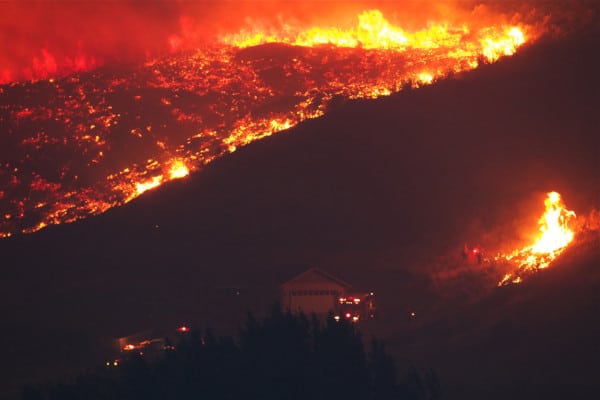When wildfires threaten, proactive steps can help protect your property
The devastating news reports emerging from Australia continue to mount. Since September, unprecedented wildfires fueled by record-breaking temperatures, months of severe drought, and strong winds have blazed through an area roughly the size of West Virginia across the continent. Millions are grasping for ways to protect their homes from wildfires.
And while recent rain had firefighters jumping for joy, the relief was short-lived.
To date, at least 25 people have died in the Australian wildfires—including three volunteer firefighters—and over 20 million acres have been scorched. The fires destroyed more than 1,300 homes in New South Wales (NSW), the hardest-hit state, and entire cities remain shrouded in a choking haze while firefighting teams stretch to their breaking points.
The ecological toll is just beginning to be understood. A CBS News report estimates that more than 1 billion animals have perished. Heartbreaking images of burned and orphaned members of Australia’s iconic koala population fill social media feeds, as thousands of the slow-moving animals succumb to flames. Advocates worry that those who survive will slowly starve as the fires scald their habitats.
To put the 20-million-acre scope of the Australian wildfires in perspective, about 4.6 million acres burned in the 2019 Amazon fires and about 2 million acres were lost during California’s terrible 2018 wildfire season, which included the Camp Fire—estimated as the most expensive natural disaster in the world that year.
Yet even as Americans pour millions of dollars in support and firefighting expertise to help Australia try to control its out-of-control flames, we know our turn is coming. In this blog, we explain strategies for protecting your home if you live in a part of the U.S. that suffers a high risk of wildfires.
QRFS offers many products that can help protect your home, including residential fire sprinklers and fire extinguishers. We also carry the Bumperless Dual-Range Fire Hose Nozzle that seamlessly transitions between a fog spray, straight stream, and the off position and meets Forest Service Specification 5100-239C for wildland firefighting gear.
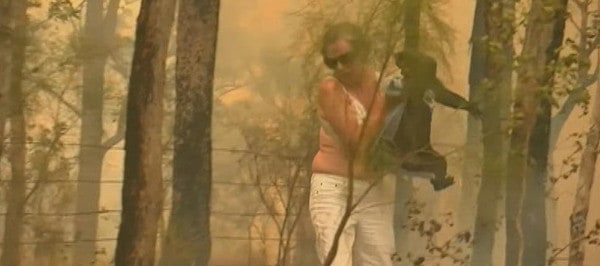
How wildfires start
Wildfires arrive like clockwork in the western U.S. during the summer and fall when hot air, dry land, and strong winds can easily spark super-sized blazes. But since the 1970s, the area of the land that’s burned has quintupled.
Southern California’s wettest December in nearly a decade quashed any lingering danger from the furious, wind-driven wildfires that ravaged the state in the fall. But the dry winter and hotter-than-usual start to 2020 that’s predicted could cause “red flag” conditions to return as early as April. A red-flag warning occurs when warm temperatures, low humidity, and strong winds create an increased risk of fire danger.
Natural causes like lightning strikes in drought-parched forests trigger most wildfires, but careless or malicious humans often play a role as well. Australian police have arrested 24 people on suspicion of arson as firefighters continue to fight the flames.
Wildfires can range from small blazes in isolated areas to massive infernos that cover acres of land. Some start and are contained in a matter of days but the biggest fires may burn for months.
KTLA called the conditions that fanned California’s wildfires in October “unprecedented.” But a study published by Earth’s Future asserts that Americans should expect large wildfires to become more frequent in the west as fall rains arrive later and later, turning swaths of dry vegetation into kindling that’s ready to spark when gusty winds start up in November.
KTLA notes that the California Department of Forestry and Fire Protection (Cal Fire) stopped using the term “fire season” about 15 years ago; in some parts of California, the danger lasts all year.
In wildfire-prone ecosystems, many inflammatory factors—changing climates, corporate negligence, and forest management policies that go back decades—are beyond homeowners’ control. But experts who study these conflagrations say there are many things you can do to protect your home from wildfires.
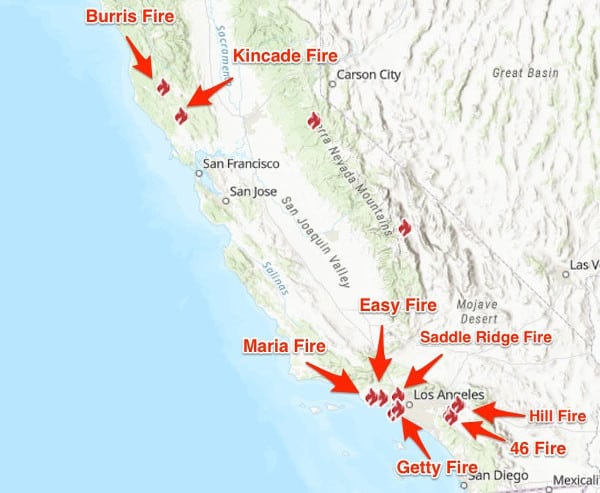
Wildfire 101: What causes a home to burn
Despite the footage of walls of flames that saturate the media at the height of summer and fall, wildfires don’t simply march across a landscape, incinerating everything in their path. They need fuel sources to keep burning.
The National Fire Protection Association (NFPA) states that embers and small flames spark most home ignitions during wildfires. Embers are burning pieces of airborne wood or vegetation that can be carried by the wind for more than a mile, triggering spot fires and igniting homes, debris, and other objects.
A home’s ability to survive a wildfire comes down to two factors: the quality of the defensible space around it and its structural ignitability. Together, these factors form what NFPA calls “The Home Ignition Zone (HIZ),” which includes the condition of the house and everything around it up to 200’ feet from the foundation.
No house will ever be completely fireproof; it’s impossible to stop embers from blowing in or grass from sparking when wildfires are near. And when temperatures reach 2,000°F as they did during the Tunnel Fire in the Oakland hills area of California in 1991, nothing can survive.
Ultimately, the goal of wildfire preparation measures isn’t to achieve the insurmountable task of fireproofing a property. Rather, it’s to reduce or eliminate fuel and ignition sources within the HIZ. Let’s examine some strategies for preparing your house to withstand ember attacks and minimizing the likelihood of flames or surface fire touching the home or any of its attachments.
Watch this NFPA video to learn more about how wildfires start and what causes a home to burn:
Creating defensible space around a home can slow or divert wildfires
Radiant heat from a massive wildfire can ignite a house from as far as 100 feet away. And if there is enough combustible material in its path, it won’t take long for the flames themselves to close the distance.
The area within 100 feet of a home stands as its first line of defense against wildfires. Turning this area into a “defensible space” that can slow or prevent flames from reaching a house—while providing firefighters a safe place to combat the blaze—gives homes a fighting chance against an approaching wildfire. It also works in reverse, reducing the chance that a structure fire spreads to neighboring homes or forest.
Remember, wildfires can only burn in places they find fuel. Within a defensible space, natural and manmade fuels are treated, cleared, or reduced to slow a fire’s spread or divert it around the home.
Now read this carefully: Some homeowners go overboard when creating a defensible space, clearing all vegetation from the area. But an area with no vegetation at all essentially creates a bowling alley for fires to toss embers at your home, asserts the California Chapparal Institute (CCI), a non-profit organization dedicated to the research and conservation of chaparral habitats in California. While it seems counter-intuitive, some well-spaced plant life can actually block wind-blown embers from reaching a house.
A better plan of attack, NFPA cautions, is carving the defensible space into three management zones around a property:
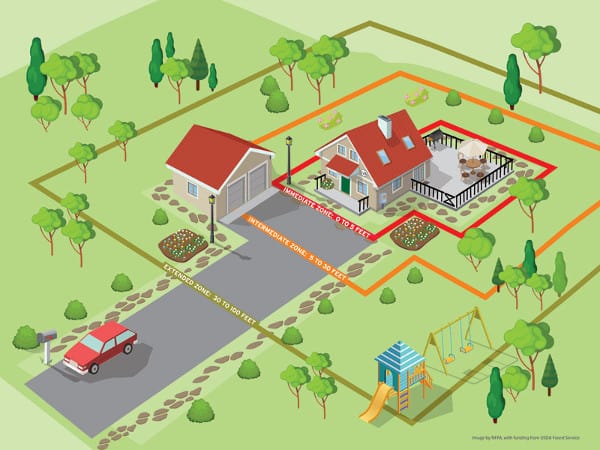
Zone 1: The Immediate Zone
Zone 1 includes the area within 5’ of the farthest point of your home (or other structures you want to protect on your property). It requires maximum hazard reduction and completely removing fuel sources like fire-prone vegetation, wood decks, and wood patio furniture from the area. NFPA also recommends separating wood fences from the house with a masonry or metal barrier. After all, something catching fire that touches a house can be just as disastrous as embers hitting the roof.
An often-overlooked danger is mulch, which creates a significant fire hazard when it lines plant beds next to the house. NFPA recommends replacing organic mulch within Zone 1 with gravel or stone. Plants containing oils and resins like juniper and pine are also particularly dangerous.
But any dry vegetation can fan flames, so be sure to regularly water and maintain any plant life near the house and remove anything dead or dying.
For Zone 1, NFPA advises:
- Clean the roof and gutters of dead leaves, debris, and pine needles that could catch embers.
- Replace or repair any loose or missing shingles or roof tiles to prevent embers from falling inside.
- Block embers from passing through vents in the eaves by installing 1/8” metal mesh screening.
- Clean debris from exterior attic vents and install 1/8” metal mesh screening to keep embers out of the attic.
- Repair or replace damaged or loose window screens and any broken windows.
- Screen or box-in areas below patios and decks with wire mesh to prevent debris and combustible materials from accumulating. Remove anything already stored underneath decks or porches.
- Move any flammable material away from your home’s exterior walls, including mulch, flammable plants, leaves, needles, firewood piles, and materials from building projects. Store firewood stacks at least 30 feet from the house.
- Maintain your irrigation system. Some sprinklers can be designed and installed to protect the landscape areas surrounding buildings from wildfires.
- Store flammable liquids in approved metal safety cans.
Zone 2: The Intermediate Zone
This transitional zone falls within 5’ and 30’ from the farthest exterior point of a home. Landscaping and hardscaping should be carefully designed to create breaks that can influence a fire’s behavior. Fire departments in high-risk states like Colorado, California, and Nevada encourage homeowners to remove flammable vegetation within 30 feet of their homes through programs that help haul away yard waste.
For Zone 2, NFPA advises:
- Create breaks in fuel sources for wildfires with driveways, walkways, patios, and decks.
- Keep lawns and native grasses mowed to a height of four inches.
- Remove ladder fuels (vegetation under trees) so ground fire can’t climb toward the crowns, or tops, of trees. Prune trees about 6’ to 10’ from the ground; for shorter trees, don’t exceed 1/3 of the tree’s overall height.
- Space trees with a minimum of 18’ between crowns, increasing the distance with the percentage of the ground’s slope.
- Mature tree canopy should be no closer than 10’ from the edge of your home.
- Limit trees and shrubs to small clusters to break up the continuity of the vegetation across the zone.

Zone 3: The Extended Zone
This zone stretches the last 30’ to 100’ from a home and can go as far as 200’, although some sources like CCI question the necessity of the longer distance.
The goal of this zone isn’t to eliminate fire but to interrupt its path and keep flames smaller and on the ground. It should be maintained as a “reduced fuel zone,” meaning plants should be spaced out, low-hanging tree branches should be pruned, dead wood should be removed, all vegetation should be regularly watered, and steps should be taken to prevent the growth of weedy grasses.
For Zone 3, NFPA advises:
- Keep propane tanks at least 30’ from the house. Clear vegetation beneath and at least 10’ around them.
- Remove heavy accumulations of ground litter and debris.
- Remove dead plant and tree material.
- Remove small conifers growing between mature trees.
- Remove vegetation adjacent to storage sheds or other outbuildings within this area.
- Trees 30’ to 60’ from the home should have at least 12’ between canopy tops.
- Trees 60’ to 100’ from the home should have at least 6’ between canopy tops.
Watch this NFPA video for more tips about creating a defensible space around your home:
Building and retrofitting with non-flammable materials is one of the ways to protect your home from wildfires
Make your roof fire-resistant
A roof’s broad expanse is like an open invitation to windblown embers, making it the most vulnerable part of a home. If your roof is flammable, any other protection measures you implement may not keep your house from burning.
Roof materials are rated from A to C for resistance to fire, with A being the most resistant. And a roof constructed from non-flammable materials like asphalt shingles, metal, slate, or tile is the best protection from wildfires.
Homeowners with wooden roofs who don’t want to reroof can try protecting their homes with exterior fire sprinklers, credited with saving 188 properties—including homes and resorts—during the Ham Lake Fire in Minnesota in 2007. Exterior sprinklers work by wetting a property’s potential fuels so they are less likely to ignite, by increasing humidity, and by creating a cooler microclimate around a structure. They are typically installed on the roof along the ridgeline, underneath the eaves, and/or along soffits.
But while organizations like CCI advocate for the widespread use of exterior sprinklers, some wildfire experts question their effectiveness. Naysayers raise concerns about robbing firefighters of desperately needed water pressure, the wind blowing water away from the house, power outages and low water pressure disabling water pumps, and panicked people forgetting or not having the time to turn sprinklers on before they evacuate. Automatic exterior sprinklers are readily available but they do increase the expense of home defense.
The Federal Emergency Management Agency (FEMA) offers guidance about installing exterior sprinklers on new and existing buildings in wildfire zones. Incidentally, climbing your roof to wet it with a hose when a fire approaches can be dangerous and is not advisable. If you fall or are injured, firefighters will need to rescue you instead of focusing their efforts on the fire.
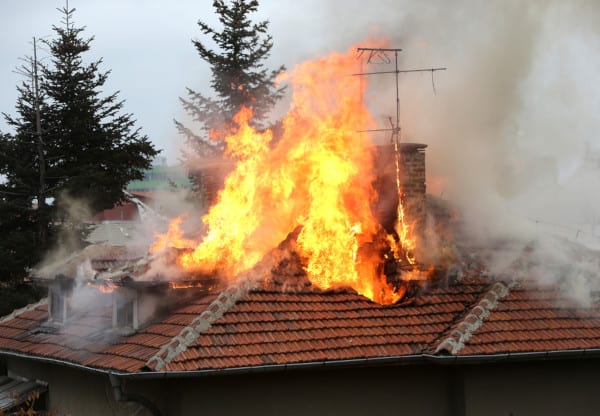
Keep embers out to avoid catastrophic fires
From carpets to shades to furnishings, modern homes are filled with flammable, synthetic materials that burn hotter and faster than ever before. If embers from a wildfire manage to get inside, the results can quickly become catastrophic.
A guiding mantra when preparing a structure to withstand wildfires should simply be: keep embers out. That means covering any exterior vent openings with 1/8” or smaller wire mesh. If you have a doggy door, make sure it seals properly and leave it closed during fire season. Embers often penetrate through openings in roofs or siding, so replace missing shingles or tiles and caulk any cracks as quickly as possible.
Windows are another point of weakness. Radiant heat can melt plastic skylights and cause glass windows to crack or even burst, allowing embers to infiltrate the house. Updating windows with double-paned and/or tempered glass enable them to better withstand high temperatures.
FEMA offers pre-disaster grants to help people retrofit homes to make them more fire-safe. While individual homeowners can’t apply alone, non-profit organizations can apply on behalf of a community.

FEMA also emphasizes that interior residential fire sprinklers can mitigate wildfire damage, activating automatically long before a fire can engulf a house. Not only can interior sprinklers prevent substantial damage to the home itself, but they can stop the fire from spreading to nearby structures or vegetation.
Some wildfire-prone areas (like the state of California) maintain residential sprinkler requirements, even mandating their use in some attics and garages, for all new homes or certain remodeled homes state-wide.
While the homebuilding industry has fought attempts by state governments to require sprinklers in new homes, there is no denying their effectiveness at stopping fires. Homes with sprinkler systems installed have an 81 percent lower death rate than homes without them. Fire-based property damage is also substantially reduced as sprinkler systems contain fires to the room of origin a whopping 97 percent of the time.
Follow these tips to help strengthen your home’s ability to withstand wildfires:
- Use fire-resistant materials wherever possible, especially on roofs.
- Fire will always exploit the weakest link. Deny it any entry point to your home. Staple metal window screening over any openings or gaps, including low decks, walkways, and crawl spaces.
- Install a residential fire sprinkler system and keep it in working order.
- Don’t let tinder like dead leaves accumulate on your roof, in gutters and vents, or under decks.
- Windows and skylights may break or burn at relatively low heat. Consider reducing the size and number of windows facing wooded areas and removing skylights. At a minimum, use thermal-pane glass. Operable metal shutters and fire-resistant curtains can also reduce risk.
- Avoid providing fire with fuel and pathways to your house via wooden trellises, fences, or sheds.
- Install spark arresters in chimneys.
- Cover exterior walls with fire-resistant materials like stucco, stone, or brick. Vinyl siding can melt and is not recommended in wildfire zones.
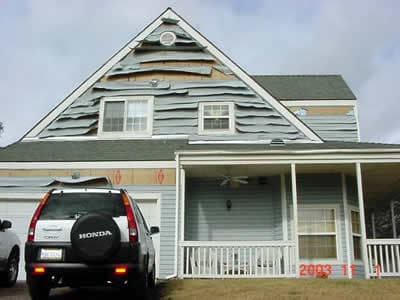
Increase the safety of your home when wildfires start
Of course, even the most well-prepared home can face serious risks if the fire comes close or neighboring houses ignite. Many homes stand closer than 100 feet to their neighbors, making them only as fireproof as their neighborhood’s weakest link. That makes community-organized fire preparation plans as important as what you do to your individual property. NFPA’s Firewise USA program helps people adapt to living in wildfire zones and encourages communities to work together to prevent losses.
Becoming familiar with your community’s disaster preparedness plans and creating a plan for your family is also essential. Identify escape routes from your home and neighborhood and designate an emergency meeting place where family members can reunite if separated.
It’s also wise to have an emergency kit on hand that includes such items as first aid supplies, a portable radio, basic tools, a flashlight, extra car and house keys, credit cards and cash, extra eyeglasses, work gloves, prescription medications, blankets, baby items, and important documents like insurance policies.
More homes and lives are threatened by wildfires every year. Following these fire safety tips can increase your home’s safety and survival if wildfires approach your area.
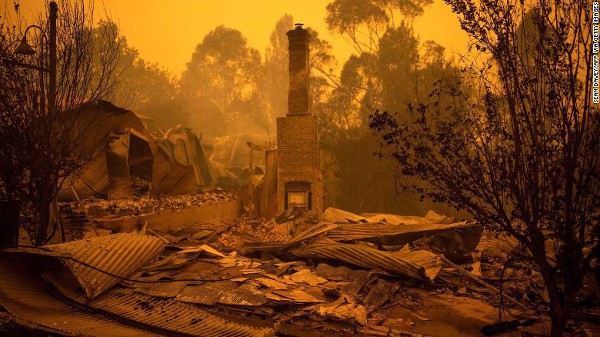
Want to learn more about how firefighters fight fire? Check out our blog Fire Safety Technology: Innovative Equipment for Firefighters.
QRFS offers many products that can help protect your home, including residential fire sprinklers and fire extinguishers. We also carry the Bumperless Dual-Range Fire Hose Nozzle that seamlessly transitions between a fog spray, straight stream, and the off position and meets Forest Service Specification 5100-239C for wildland firefighting gear.
If you have questions or need help finding an item, call us at +1 (888) 361-6662 or email support@qrfs.com.
This blog was originally posted at blog.qrfs.com. Check us out at Facebook.com/QuickResponseFireSupply or on Twitter @QuickResponseFS.


